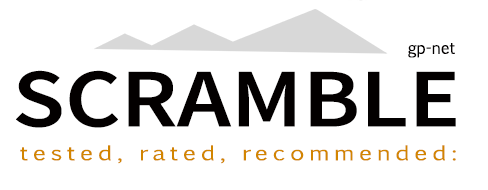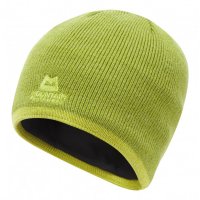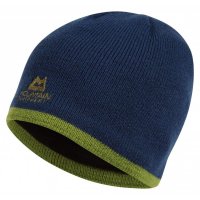Mountain Equipment's Plain Knitted Beanie
Preface
As always, we're looking at the Mountain Equipment Plain Knitted Beanie from the point of view of long distance trekking over tough terrain.
Test subject: Head circumference: 57.5cm (22.5") = Medium
Test item: Kiwi (One Size)
Kit Tests: Winter
Disclaimer: None required (item not provided by manufacturer)
Datasheet
| Materials: Wool / Acrylic | 50% / 50% |
| Weight | 57g |
| Manufacturer RRP | £25.00 |
Scramble Review
Introduction: Hoods for Protection; Hats for Warmth
Hats are extremely versatile whereas hoods aren't. We prefer light, weather resistant hoods (which provide protection from wind and precipitation, rather than heavy duty insulated hoods that provide warmth). This reduces the insulated jacket's overall weight and allows more versatile headwear combos to do the thermal heavy lifting.
There are a staggering number of beanies on the market, and though they all look approximately the same, there are substantive differences, predominantly in terms of cut and choice of materials. We think Mountain Equipment have got theirs spot on. Here's why ...
What are the ideal materials for cold weather beanies?
A study by R. Indu Shekar et al (Textiles Division, Defence Materials and Stores Research & Development, Kanpur, India, May 2000) investigated five different blended materials and four different weaves to determine their insulation properties under wet and dry conditions.
Materials:
- wool/polypropylene (50/50)
- wool/polypropylene (70/30)
- wool/acrylic (50/50)
- wool/acrylic (70/30)
- wool/jute (85/15)
Weaves:
- wool/polypropylene (plain knit)
- wool/acrylic (rib knit)
- wool/acrylic (plain knit)
- 100% polypropylene (terry)
To save you a rather dull read, the best insulation score was achieved by the 50/50 Wool-Acrylic blend (using a plain or rib knit, with rib scoring a fraction higher than plain, presumably due to trapping slightly more air).
So that's the blend and weave covered. Mountain Equipment clearly know what they're doing and have used the ideal blend for warmth in both dry and wet conditions.
What other properties does this blend of acrylic and wool provide?
Material Properties
Acrylic
Acrylics are generally characterised by having high loft and resilience. The fibres are durable, soft, and remain resilient on contact with moisture. Acrylic fibres are hydrophobic, so don't absorb sweat; instead moisture is pushed away from the source to the surface where it evaporates. Acrylic is lightweight, warm and quick drying.
Wool
Wool is an excellent insulator with one of the highest insulation to weight ratios of any natural or man-made fibre. It insulates when wet, it's breathable, moisture wicking, temperature regulating, resilient and elastic (maintains shape over time). It doesn't retain odours and will freshen with a simple airing. The outer layer of wool fibres have a high concentration of fatty acids with anti-bacterial properties.
Blended
Acrylic and wool each have properties ideal for a warm winter hat. Combining the two materials aids fibre stability, elasticity (maintains shape), loft, durability and enhances insulation. The warmth and wicking capabilities of wool are retained, while the acrylic keeps the weight down, resilience up and reduces moisture absorption and thus quickens drying time.
The Mountain Equipment Plain Knitted Beanie
ME's Plain Knitted Beanie (not to be confused with their "Branded Knitted Beanie") simply reflects the collected properties mentioned above. Two things to add though:
1) Its cut is excellent, providing full coverage of the ears and upper neck. The micro-fleece inner band is a nice comfortable touch and provides additional warmth.
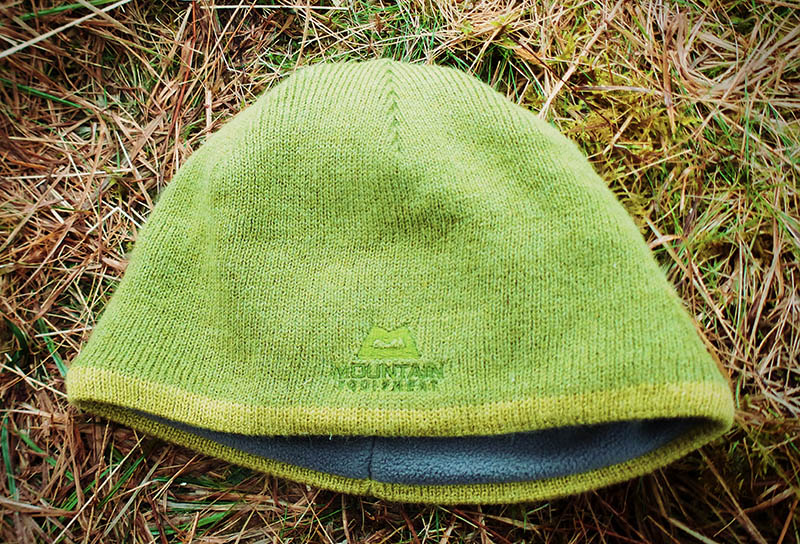 ME's Plain Knitted Beanie: A hint of fleece
ME's Plain Knitted Beanie: A hint of fleece
2) Although all beanies look alike, they really are not alike at all. One of the major weaknesses of many beanies is that over time, they lose their shape and elasticity. Mountain Equipment's Plain Knitted Beanie holds and retains its shape well (due to its materials and also the fleece headband helps); its elasticity allows it to fit over supplementary headwear for more extreme conditions.
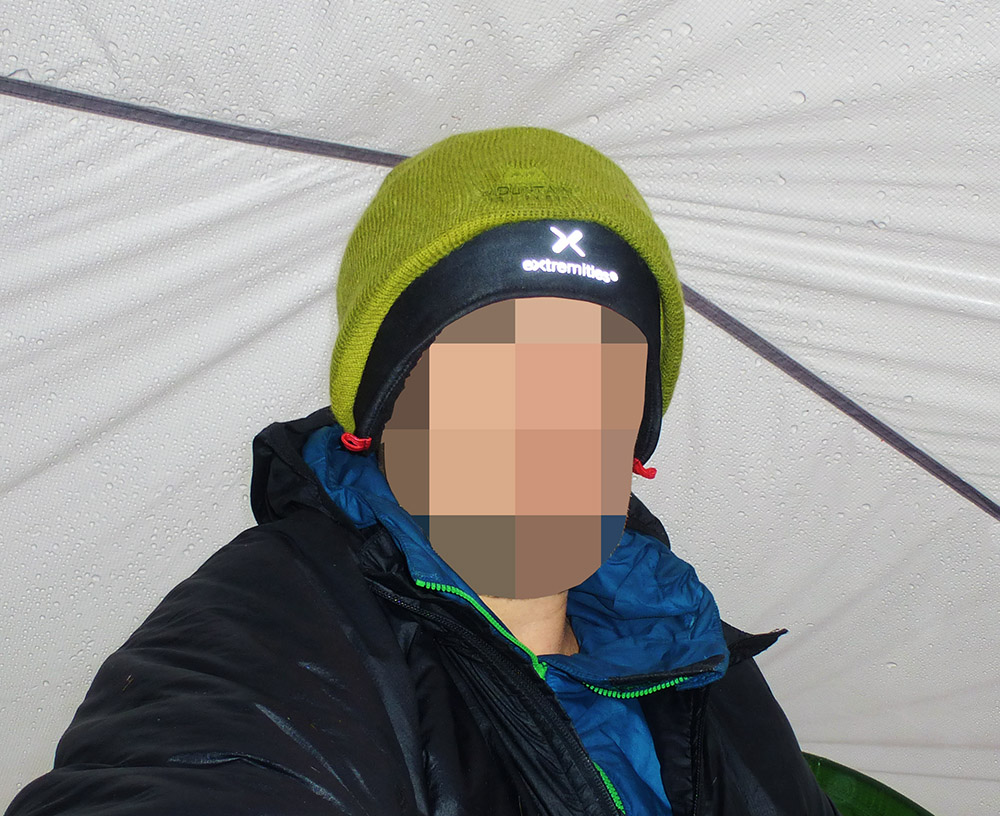 The Extremities Super Windy Took under ME's Plain Knitted Beanie
The Extremities Super Windy Took under ME's Plain Knitted Beanie
Weighing 115g in total, with a mix of pile fleece, wool and acrylic covered by Gore Windstopper fabric, this duo is incredibly warm and wind resistant, even more so under the Mountain Equipment Compressor's (Primaloft insulated) hood. All I can say is I hope I never go anywhere so cold, that this is not sufficient - like to Hell, after it's frozen over.
Most high quality winter hats and beanies weigh over 60g, the ME Plain Knitted Beanie comes in just under at 57g and compresses down reasonably well.
Any Negatives?
No.
Conclusion & Rating
Are there more beanie variants than stars in our galaxy? Absolutely not, it just seems like there are. So if you're lost in the beanie-way, and can't decide between Bergans' Tine, Montane's Resolute, Sweet Protection's Partisan, Icebreaker's Mogul, Mountain Hardwear's Reversible Dome and on and on, and are fearful of choosing a dud (there are many out there), give Mountain Equipment's reliable Plain Knitted Beanie a go. Mountain Equipment have chosen the ideal materials in an ideal blend. The shape and fit are spot on, and the micro-fleece headband is a comfortable and functional addition.
We've ended our quest for the ideal beanie - now we can leave the beanie-verse ... at least until Hell freezes over.
Product Images
Rating (out of 10)
* The value score is derived from two factors:
1) Competitive Market Price (CMP). This represents our judgement of a competitive online price point if we were to stock the item. e.g. if we feel we would need to sell an item at 40% off (i.e. 60% of its full RRP) to be competitive, then our CMP score will be 6/10.
2) Customer Value Price (CVP). We then make an honest appraisal of the maximum price we would be willing to pay for the item (and we're mean). So if we'd pay 80% of its RRP our CVP score would be 8/10.
We then average the two scores to get our final value score, which in our example would be 7/10.
Last Updated: 23/05/17
